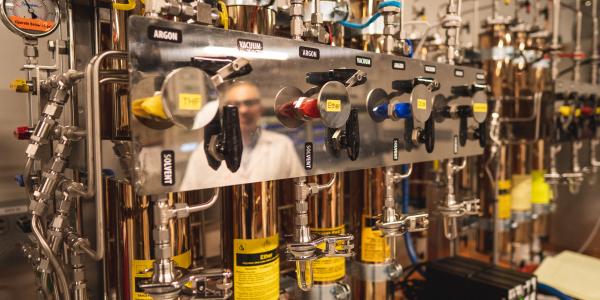Wilson Bailey and Caitlin Bouchey moved with the Tolman Lab last summer from Minnesota to Missouri. Though they described the move as hard work, Bailey and Bouchey also appreciated how the moving experience prepared them to set up and run their own chemistry labs one day.
Moving a chemistry lab is a rare occurrence with good reason. The labor required and logistics involved are far more intense than a standard residential move. Below, Bailey and Bouchey share their top tips and insights from moving the Tolman Lab.
What are the top 7 things to know about moving a chemistry lab?
- There’s no getting around it – the move is going to be incredibly stressful. "Take care of yourself while your whole life is moving," Bailey said. "You’re moving your home and your work. It feels never-ending, but there is an end date!" He offers this advice for keeping calm during a hectic move: "Things will go wrong, and aspects of the move will surprise you, but as long as you're able to roll with the punches, you'll find plenty of good surprises." Bouchey added this pro tip: "Plan time for breaks and fun events. For example, the lab would do a full day of cleaning and packing, then go out for happy hour together."
- Mentally prepare for a long haul. "It will take lots longer than you think. Even with very good planning, the move will still take longer than you think and longer than your PI tells you," Bouchey said, then added with a laugh, "not to name names or anything."
- Befriend staff members at both universities. They will be invaluable resources during the move. Stockroom and facilities managers are especially helpful. "Look for people who have the answers to your questions, and keep them close," Bailey advised. He added, "The WashU staff was with us every step of the way. Gary [Broyles, chemistry building supervisor] was instrumental, and he loved it!" Bouchey recalled, "On the Minnesota end, we had lots of help with proper waste and chemical disposal, as well as bigger equipment decommissioning."
- Be organized and communicative. Maintain open and frequent lines of communication with your boss, lab mates, and facilities managers. Bouchey recommended using shared Google documents to keep everyone in the loop and up to date. "There are so many moving parts – packing, moving, shipping – with different things happening at different times," she said. "Using shared checklists for each piece allowed us to stay organized and check off items as we completed them."
Wilson Bailey describes how the lab was set up with four tanks of argon to supply all the fume hoods. These are fed from a single outgoing line, rather than individual lines. - Start working on chemicals first. Make sure everything is clearly labeled, and have a process in place to dispose of legacy chemicals. Bailey and Bouchey described packing up chemicals as the biggest time commitment. "Definitely get to know the person who knows how to ship chemicals," Bailey said. "Environmental Health and Safety and the Department of Transportation have rules for how to package chemicals. Handling everything properly will take lots of time." Bouchey shared general best practices: "We ended up throwing out hundreds of chemicals, but it changed our outlook on buying and storing chemicals. Now we know to keep better track of what we're buying and how much. Thanks to the move, we're more aware of how to reduce waste going forward."
- Do things in chunks. Start in one space, then move to another. This will require focused organization, but being patient and methodical will help make the move smoother. Bouchey said, "Sit down, make a plan, mark your calendar, and make sure it can all really happen. Keep in mind deadlines and other commitments. Be realistic about your expectations. You're looking at months of not doing chemistry, including slowing down before the move and slowly restarting after. 'How will this impact graduation time?' is a definite concern, but changing research groups would likely delay more."
- Last, but certainly not least, Bailey and Bouchey could not overstate the importance of finding a reputable scientific moving company. "Once you have everything clean [of chemicals], you can let the moving company do the packing," Bouchey said. "They know how to pack and ship delicate, expensive glassware with almost no breakage."
What turned out to be much easier than you anticpated? Harder than anticipated?
Bouchey: "Moving physical stuff, like glassware, is super easy with a good mover. Once you have everything clean and labeled, the movers do all the work. Getting everything free of chemicals in the first place, though, that was much harder than anticipated."
Bailey: "Moving a glove box without shutting it down turned out to be surprisingly easy. It took maybe five minutes with no real planning. We just had a few people push it into the elevator, then rolled it into the new lab and plugged it in. Leaving friends behind was much, much harder. Moving takes a big toll on partners, who also have to give up their jobs and move their whole lives. Communication is again key to making this work, especially when it comes to weighing the benefits of undertaking such a big change."
Were any parts of this move fun?
Bouchey: "It's been fun to see and explore a new city, especially discovering new favorite places."
Bailey: "Being part of redesigning Bryan Hall, working with engineers and architects, has been an amazing opportunity that lots of other students don't have. We're lucky that Bill [Tolman] invited us in. Now that we're here, it's fun to see what we've built and accomplished, both in the space itself and in terms of building a new research group."
What do you know now that you wish you'd known at the beginning of the moving process?
Bouchey: "I didn't realize how excited I'd be about a brand new lab. There's so much possibility in a clean, new space. Everyone has been so helpful and welcoming. It's wonderful to have people excited we're here, everyone asking what they can do to help us establish ourselves. Rachel [Dunn, administrative officer] has been especially awesome!"
Bailey: "Know that the new department won’t be the same. Every place has different ways of running and doing things, for good and bad. Be ready for change."
Top takeaways?
Bailey and Bouchey both described this move as incredibly smooth, compared to horror stories they heard from their peers. The lab was only shut down for about two months, resulting in minimal loss of research time. Even though the move took away some time from doing chemistry, their experience with moving and setting up labs will prove invaluable for Bailey and Bouchey as they look forward to starting their own labs one day.





